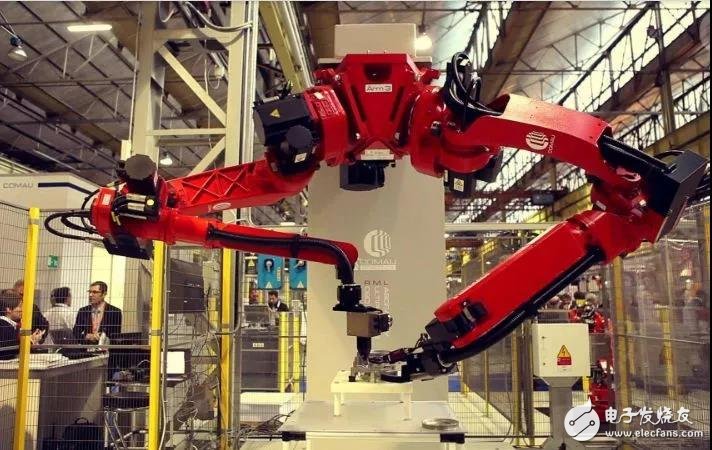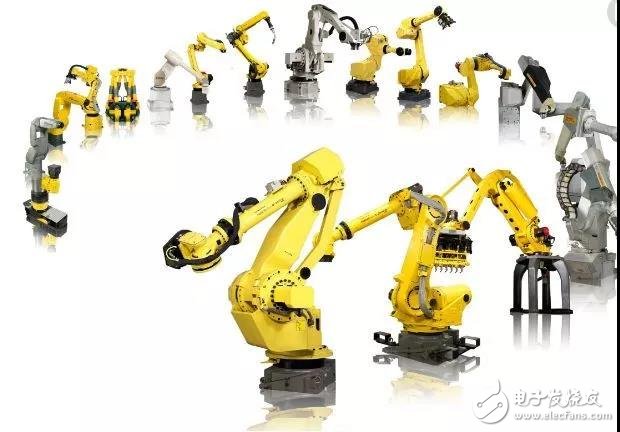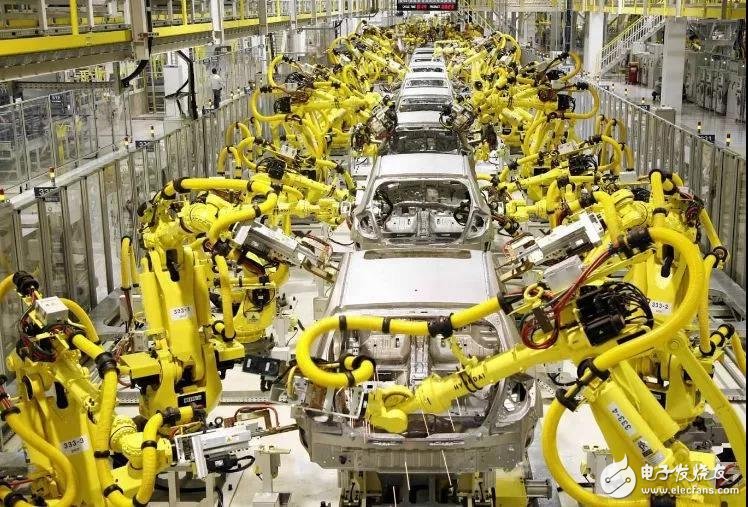From the production activities such as handling, palletizing and welding, to life activities such as reading newspapers and accompanying activities, to military activities such as mine clearance and combat, the "robot era" is coming. The robot is an important automation equipment for modern manufacturing industry integrating mechanical, electronic, control, computer, sensor, artificial intelligence and other multi-disciplinary advanced technologies. According to the application field, it is divided into industrial robots, service robots and special robots. According to the International Federation of Robotics (IFR) data, the global robot market reached US$23.2 billion in 2017, with the industrial robot market being the largest at $14.7 billion, special robots at $5.6 billion, and service robots at 29. One hundred million U.S. dollars. Since 2009, the annual sales of industrial robots worldwide has increased year by year. Driven by the continuous increase in domestic labor costs and the demand for “robot substitutionâ€, the Chinese industrial robot market began to develop rapidly in 2013. In the same year, China surpassed Japan to become the country with the largest number of robots purchased each year, and has been the world's largest application market. In 2015, it was also regarded as the "first year of Chinese robots" by the industry. In May 2015, the “Made in China 2025†plan was launched, and industrial robots were clearly included in one of the ten key areas to promote breakthrough development, promoting robot standardization and modular development, and expanding market applications. “In 2015, the industry's spurt developmentâ€, Zhu Sendi said, “The market share of Chinese domestic robots in the domestic market has increased from 26% in 2013 to 33% in 2016, and three-point worlds have domestic robots. One. In 2016, the share of the four major families exceeded 60%. In his view, 2015-2025 will be a leap forward for the Chinese robot industry, but before 2035, the Chinese robot industry is still in a catch-up period. "Card neck" problem "In the field of industrial robotics, the core components are heavily dependent on imports, which has stuck the 'neck' of the development of domestic robots," said Qu Xianming, member of the National Manufacturing Power Construction Strategy Advisory Committee and director of the Manufacturing Research Office of the Chinese Academy of Engineering. The industrial robot consists of the basic parts of the mechanical body, control system, drive and transmission system and sensor components. The industry produces three core components: reducer, servo system and controller. The midstream enterprise is the robot body manufacturer, and the downstream is the system. Integrators. Since the three core components of industrial robots account for more than 70% of the cost of robots, the long-term development of core components lags behind the development of China's industrial robot industry. For example, precision precision reducers for precise control of robot movements and transmission of greater torque are currently occupied by more than 70% of the world's precision reducer market, which are owned by two companies, Hamernaco and Nabtesco, and China relies mainly on import. However, according to data from the Intellectual Property Industry Partner Industry Research Institute, starting from 2016, with the increase in the production of domestic precision reducers, China’s imports of precision reducers began to decline. At the same time, in the field of domestic RV reducer (for robot joints of more than 20 kg), Nantong Zhenkang Machinery Co., Ltd. (hereinafter referred to as Nantong Zhenkang) also sold 28,000 units in 2017; Qinchuan Machine Tool Group also last year Achieve nearly 10,000 units of sales. The digital workshops of the two companies are also under construction, which will increase the production capacity by 60,000 units respectively. In a research report on the localization process of industrial robots, Zhongtai Securities Research Institute believes that domestic enterprises have achieved independent research and development and market promotion in some core components such as servo motors and controllers. At present, the robot reducer market is highly monopolized, and the domestically produced reducer cannot achieve full import substitution during the popularization period. Qu Xianming believes that there are three difficulties in the replacement of domestic reducers. First of all, the “professional, refined and characteristic†enterprise group engaged in the research and development and production of core components in China failed to grow up; secondly, users are more tolerant of foreign parts and demanding for domestic production; The views of the parts and components have not been completely reversed. The controller used to issue and deliver action instructions is considered the "brain" of the robot, which is the core component with the smallest gap between home and abroad. Zhongtai Securities Research reported that the controller includes hardware and software. The hardware is the domestic control brand of the industrial control board has been mastered; the software part is mainly control algorithm, secondary development, etc., domestic brands in the stability, response speed, ease of use and so on. Compared with the controller, China is completely at a disadvantage in terms of servo system. The market is almost monopolized by the Germans represented by Yaskawa and Siemens, and the national production rate is only 10%. Domestic manufacturers include Eston. Guangzhou CNC and so on. The servo system is the main source of power for industrial robots. It consists of servo motor, servo drive and encoder. The cost of the optical servo system accounts for 23% of the cost of the industrial robot body. According to the research report of the Partner Industry Research Institute, the gap between domestic servos and foreign brands is mainly reflected in the lack of high-power products, the insufficiency of miniaturized products, and the lack of high-precision encoders. In January 2018, China released the "China Manufacturing 2025" Technology Innovation Green Paper - Technology Roadmap (2017), which proposes that by 2020, domestic robots and key components with independent intellectual property rights will satisfy the domestic market. 50% supply capacity. Incremental market opportunity The domestic robot products are mainly in the middle and lower reaches. For the robot body manufacturers located in the middle of the industry, their products can only be used in the downstream to obtain sales and profits. China's industrial robots are widely used in the automotive, electronics, metal processing and other industries, and the current large-scale applications are concentrated in the automotive and electronics industries. In 2016, the two together accounted for 72% of the total. The automotive industry accounts for 43% of the market. In the automotive sector, the “four big families†of robots have occupied most markets. Li Zexiang, director of the Automation Technology Center of the Hong Kong University of Science and Technology, said: "I have always called for not to go to the auto industry to die with the 'four big families', because without the opportunity, we should move to industries with Chinese characteristics, and the giants have not yet made breakthroughs in the industry." In fact, the "Four Big Family" has their respective focuses. Fanuc relies mainly on controllers to enter the market, and robots and other businesses are expanding around its core CNC control system. Yaskawa is cutting into the market with its servo system, which has exceeded the robot's ontology business for many years. In contrast to the two Japanese companies, ABB and KUKA, which are less involved in the upstream core components sector, focus on the downstream system integration application business. As a Chinese startup that develops a control system for the small six-axis and produces both a robot body and an intelligent manufacturing solution, Meteorite (Beijing) Technology Co., Ltd. (hereinafter referred to as a meteorite robot) chooses to avoid the "Four Big Family". "Leading market, aligning with emerging incremental markets such as sewing. “There are usually a limited number of industry scenarios that can be covered by a robotic product, but China is a big manufacturing country with a large number of unique industry applications, which gives potential opportunities for meteorites,†said Yan Hua, CEO of the meteorite robot. Liu Jinchang, project director of the High Technology Center of the Ministry of Science and Technology, believes that as the capacity and demand of the robot market in China and the world continue to increase, on the one hand, Chinese companies are striving to make robots usable, durable and easy to use; on the other hand, the production capacity of domestic robots And quality is also improving, and can occupy a share in emerging market expansion. Zhu Sendi believes that domestic robots should also enter the automotive field. "Domestic robots are basically used in scenes with high labor intensity and harsh environment. We should alleviate the entry into the automotive field from some heavy physical labor," he said. In Zhusen, the path to enter the automotive industry is given. In his view, if you can't directly enter the domestic auto industry, you can export to domestic sales, first go abroad to take orders, and enter the domestic market. However, the premise of this step is to improve the reliability of the robot and ensure the normal operation of the production line. Cultivate the leading and small giant companies “Chinese robots need leading enterprises.†When asked about the problems that the Chinese robot industry still needs to solve, Chu Jianhua blurted out. In his view, the robot industry is not only a technology-intensive industry, but also requires continuous technological innovation; at the same time, the robot industry also has economies of scale, and the competitiveness of leading companies determines the competitiveness of the robot industry to some extent. “In the procurement of parts and components, the bargaining power of leading enterprises can mainly push down the cost of robots.†Liu Jinchang said, “With leading enterprises, China can compete with international giants.†Xinsong Robot Automation Co., Ltd. (300023.SZ, hereinafter referred to as Xinsong), affiliated to the Chinese Academy of Sciences, is a full-chain robot enterprise with independent core technology, core components, core products and industrial system solutions. It is also China. The top 10 core companies in the robotics industry. Chen Li, dean of Hangzhou Xinsong Robotics Research Institute, told the interface news that industrial robots are the most important equipment for constructing intelligent manufacturing systems. Without industrial robots, it is impossible to construct intelligent manufacturing systems. Industry leaders are the core strength of robotics, artificial intelligence and smart manufacturing. According to Chen Li, Xinsong is currently focusing on the development and manufacture of robotic ontology, and is also paying attention to the development of offline simulation software for robots. "This is what the foreign giants such as Siemens are doing at the present stage, and it is also an area that is expected to break through. Not so domestic robot companies have simulation software." Qu Xianming also pointed out that China should learn from the lag of chip development, subject to the teachings of people, and master the core technology of robots in their own hands. His suggestion is to cultivate a large number of "specialized, refined, and distinctive" small giant enterprises, to provide support for the robotic machine factory, and finally to the "world stealth champion". 50Hz Diesel Generator Set,50Hz Yuchai Power Generator Set,Kosta Small Power Genset,Yuchai Power Generator Set Shanghai Kosta Electric Co., Ltd. , https://www.ksdpower.com




